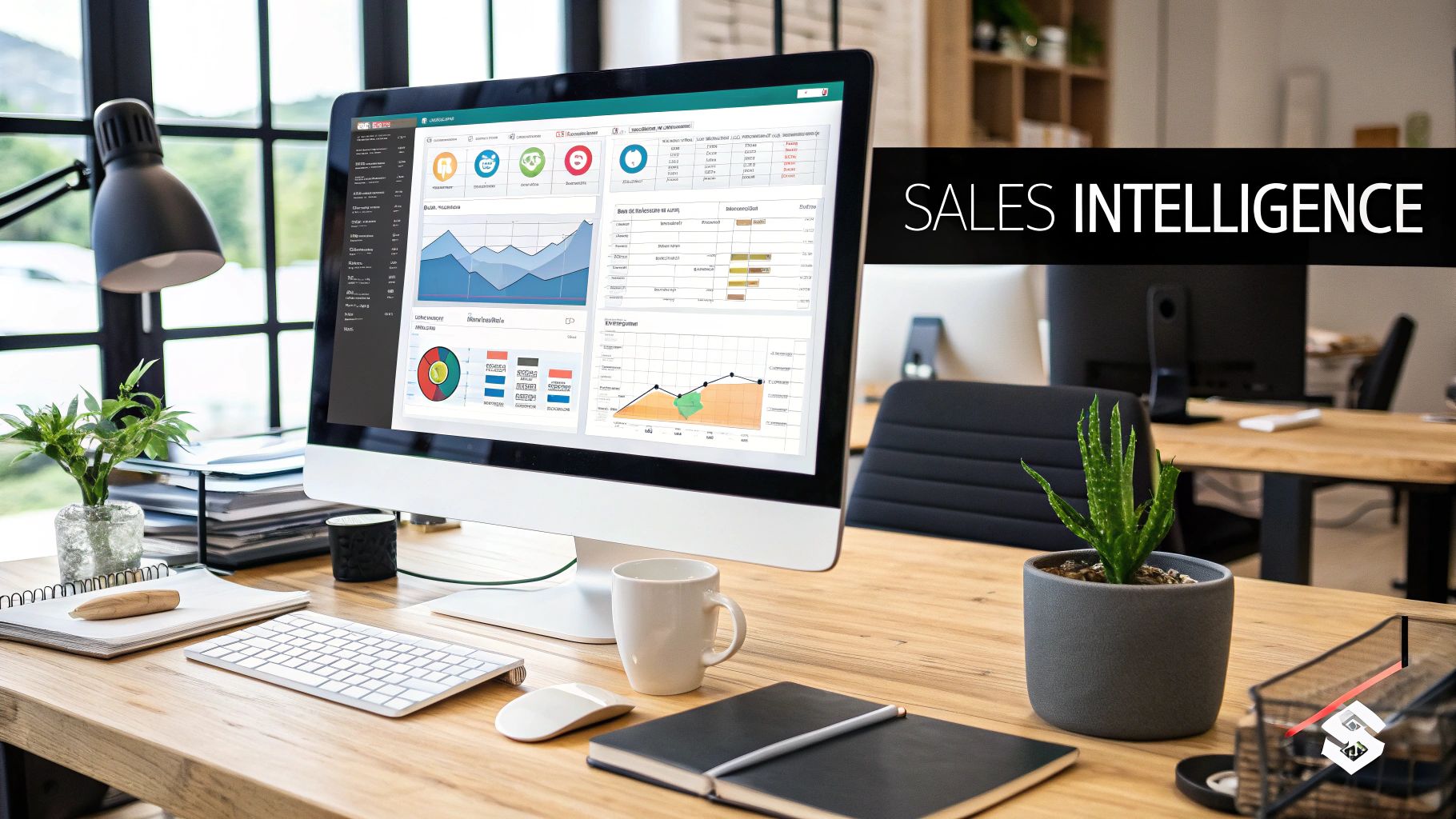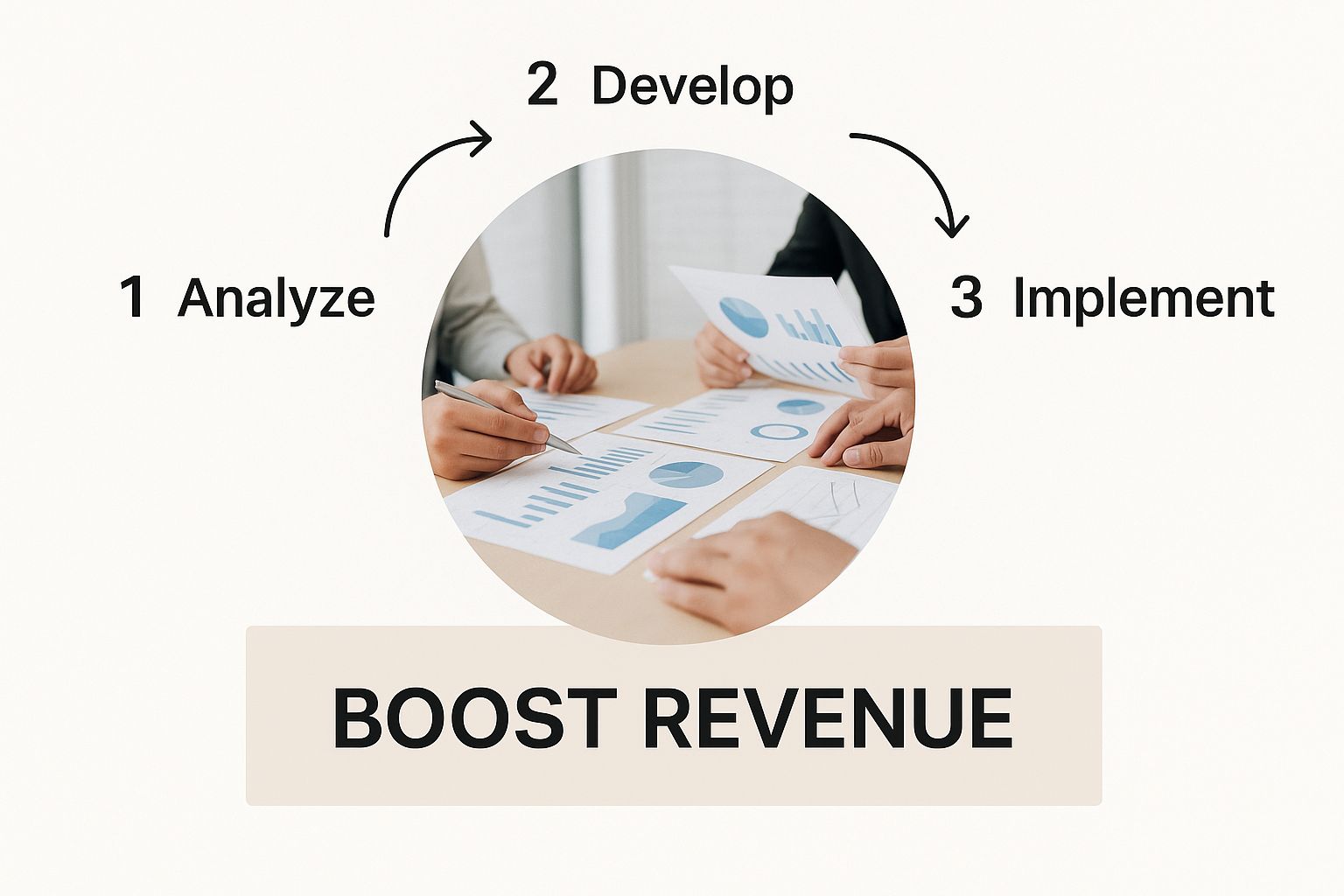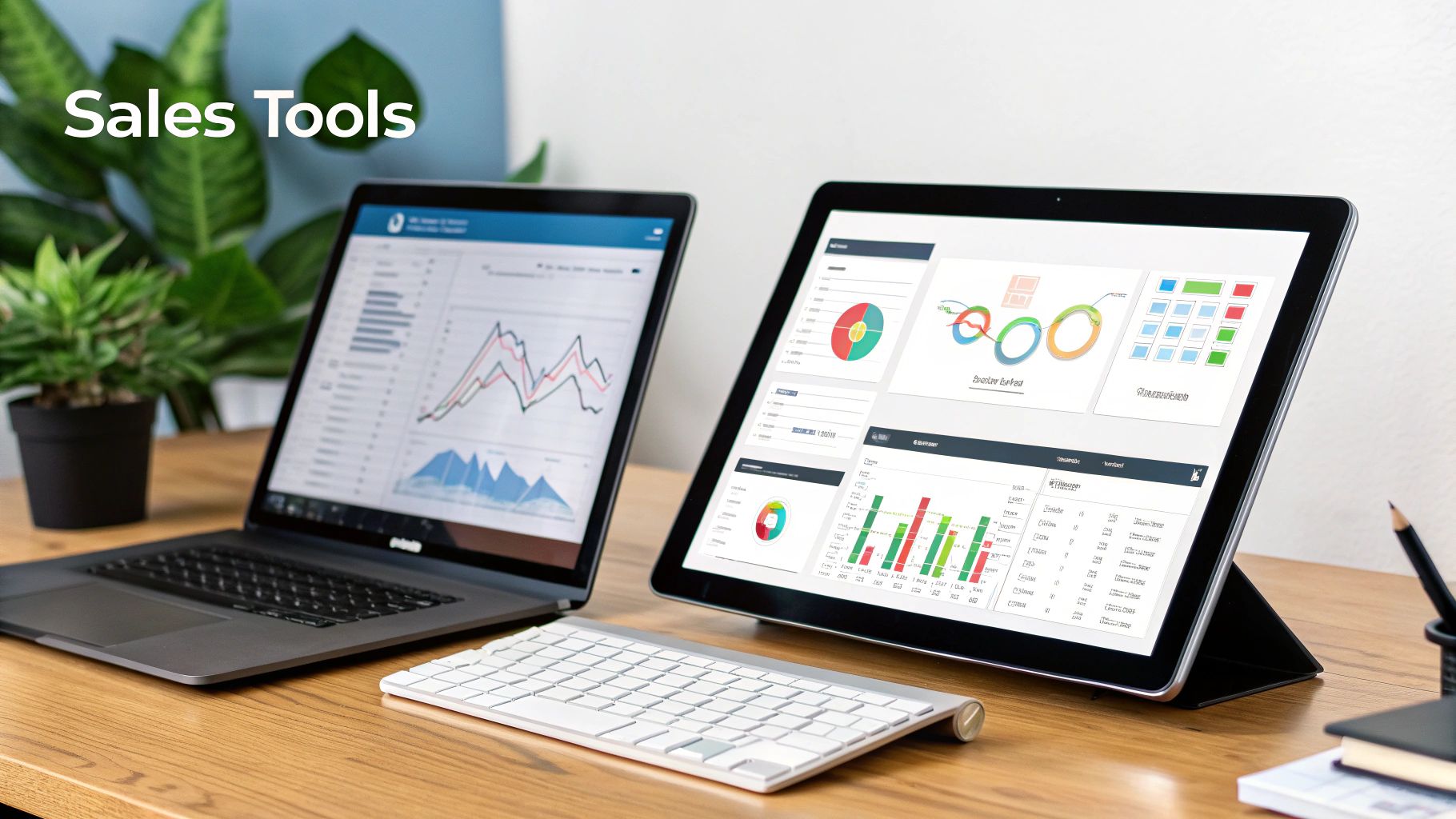So, what exactly is sales intelligence?
Think of it as the ultimate cheat sheet for your sales team. It’s the process of collecting, sorting through, and using key information about your prospects so you can sell smarter, not harder. It turns a mountain of raw data into a clear roadmap, showing you who to talk to, when to reach out, and what to say.
From Guesswork to Insight

Imagine trying to navigate a new city without a map. Sure, you might get where you're going eventually, but you'll hit plenty of dead ends and wrong turns along the way. That’s what traditional sales often feels like—reps are working off old lists, making cold calls, and just hoping something lands.
This is where sales intelligence completely changes the game. It’s not about buying another static contact list; it’s about plugging into a live feed of context and actionable insights.
Sales intelligence moves your team from guessing to knowing. It empowers them to make smart, data-backed decisions that lead directly to more closed deals.
Let's break down the difference in a practical way.
Sales Intelligence At a Glance
| Activity | Traditional Sales (Guesswork) | Sales Intelligence (Insight) |
|---|---|---|
| Finding Leads | Buys generic lists, scrapes websites. | Identifies companies actively looking for solutions. |
| Prospecting | "Hello, do you have a minute?" | "I saw you're hiring a new VP of Ops…" |
| Timing Outreach | Calls whenever they have a free moment. | Reaches out after a funding announcement. |
| The Pitch | One-size-fits-all script. | Tailors the message based on the company's tech stack. |
As you can see, the difference is night and day. One is about volume and luck, while the other is about precision and timing.
The Core Components of Sales Intelligence
At its heart, sales intelligence is built on three crucial types of data that give you a complete picture of your prospect. It goes way beyond just a name and phone number.
- Firmographic Data: This is the "who" and "where." Think company size, industry, location, and annual revenue. It helps you define your ideal customer profile.
- Technographic Data: This is the "what they use." It tells you which software, tools, and technologies a company has in its stack, revealing integration opportunities or pain points with a competitor’s product.
- Buying Signals: These are the golden nuggets—the "why now." Real-time events like a recent funding round, a new executive hire, or a company expansion signal that a prospect might be ready to buy.
When you bring these three elements together, you give your team an incredible advantage. Every call, email, and meeting is suddenly more relevant and timely. You stop being just another salesperson and start becoming a trusted advisor.
How Sales Intelligence Actually Works
So, how does this all come together? Let's pop the hood and look at the engine behind sales intelligence. Think of it less as a tool and more as a four-stage assembly line, taking scattered bits of raw information and turning them into a real competitive edge for your sales team.
It’s like having a dedicated research analyst working around the clock for every single one of your reps. The whole system is built to transform random data points into genuine opportunities that drive revenue.
Data Aggregation: The Foundation
First things first, sales intelligence platforms are essentially massive information sponges. They are constantly pulling data from thousands of different public and private sources. We're talking about a huge net that catches everything from:
- Public News: Keeping an eye on articles about a company’s latest funding round, a big product launch, or major expansion plans.
- Social Media: Noticing when an executive updates their job title on LinkedIn or when a company posts a key announcement.
- Government Filings: Combing through official records to spot signs of growth, financial health, or strategic changes.
- Website Analytics: Pinpointing which companies are visiting your website, showing clear interest.
This first step is all about gathering the raw ingredients. It’s the foundation you need before you can start building a clear picture of your market.

The key takeaway here is that sales intelligence isn't just a one-off action. It's a continuous cycle of gathering, analyzing, and delivering insights that keep your team one step ahead.
Enrichment and Analysis
Once the raw data is collected, the real magic begins. The platform gets to work enriching your existing contact information. It cleans up outdated details, fills in missing gaps like direct-dial phone numbers, and adds incredibly valuable context, like what technologies a company is currently using or its recent hiring trends.
Then, powerful analytics sift through all this enriched data to find the golden nuggets: the buying signals. These are the specific, actionable triggers that tell you a prospect is ready to talk. This is where simple information becomes true intelligence.
A buying signal is an event that screams, "This prospect needs what you're selling, right now." Think about a company just landing $20 million in Series B funding—that's a classic signal they're about to invest in growth.
Finally, all this powerful intelligence gets piped directly into your CRM. Reps no longer have to waste time bouncing between a dozen browser tabs to piece together a story. The insights are right there, inside the tools they already use every day, letting them act fast and strike while the iron is hot.
Why Sales Intelligence Is a Game-Changer for B2B Sales

In today's crowded B2B world, sales intelligence isn't just a nice-to-have tool; it's the core engine driving the most successful sales teams. It's what turns a cold, generic outreach into a warm, relevant conversation that actually goes somewhere.
Without it, your reps are basically flying blind. They're forced to guess which leads are worth their time, often wasting precious hours on dead ends with a generic pitch that falls flat. Sales intelligence flips that script. It makes every move data-driven, replacing guesswork with a clear, repeatable path to closing deals.
This shift isn't a secret. It's why the sales intelligence market is booming, jumping from USD 3.61 billion to USD 3.99 billion in a single year. It's even projected to hit nearly USD 6.94 billion soon. That kind of growth tells you something big is happening.
Stop Chasing Bad Leads
One of the biggest time-sinks for any sales team is chasing leads that were never going to buy in the first place. Sales intelligence puts an end to that by helping you focus all your energy on the accounts that are actually ready to talk.
These platforms dig into all kinds of data—firmographics, technographics, and buying signals—to score your leads. A rep can see in an instant which companies fit your ideal customer profile and are actively looking for a solution right now.
This means less time spinning your wheels and more time engaging prospects who have a real problem you can solve.
Make Every Outreach Feel Personal
Let's be honest: generic, one-size-fits-all emails get deleted on sight. Sales intelligence gives you the ammo to write messages that cut through the noise because they speak directly to a prospect's specific situation.
Instead of the tired "I'd love to connect," you can say, "I saw your company just landed its Series A funding and is hiring a new Head of Engineering. Our platform is built to help scaling tech teams like yours streamline their development pipeline."
See the difference? This approach shows you've done your homework. It instantly frames you as a helpful expert, not just another salesperson clogging their inbox. For more real-world tips, check out our guide on how to prospect effectively.
This kind of personalized touch doesn't just get you more replies; it builds genuine rapport from the first email and helps you connect with buyers when they need you most.
Putting Sales Intelligence Into Practice
Okay, let's stop talking theory and get down to brass tacks. How does sales intelligence actually work in the real world? It's all about turning raw data into smarter conversations and, ultimately, more closed deals.
Think of it this way. Meet Alex, a sales rep. The old way of doing things was to hammer through a generic list of companies, hoping for a lucky break. It was a numbers game, and a frustrating one at that.
But with sales intelligence, Alex's game has changed completely.
From Cold Calls to Warm Conversations
Instead of a blind cold call, Alex now uses a sales intelligence platform to watch for buying signals. This morning, the system flagged a target company that just posted three new job openings for "Senior AWS Engineers."
Boom. That’s not a random data point; it’s a bright green light. Alex knows this company is doubling down on its cloud infrastructure, a perfect fit for the software Alex sells. The outreach isn't cold anymore—it's a timely, relevant conversation about solving a problem the company is actively trying to fix right now.
Catching Opportunities Before They're Obvious
Sales intelligence is also brilliant at spotting trigger events—those little moments that signal a big change is coming. For example, Alex gets an alert: a key account just announced a major expansion into the European market.
This is a huge trigger. It tells Alex that the company is about to run into a whole new set of headaches with logistics, compliance, and scaling their operations. Now, Alex can craft a pitch that speaks directly to those international growing pains, showing how their product is the perfect solution.
This kind of proactive work is also a core part of effective competitive intelligence gathering, letting you get a jump on the competition.
When you track events like these, you stop reacting to what the market did yesterday. You start anticipating what your prospects will need tomorrow. You’re showing up right when they need you most.
It’s no wonder the sales intelligence market is on a tear. More and more teams are seeing the value in this approach.
This growth isn't just hype. It's fueled by the incredible ROI companies get when they stop guessing and start using data to find the right people at the right time.
Finally, this approach helps you find whole new ponds to fish in. By looking at the firmographic and technographic data of your best customers, a good sales intelligence tool can find "lookalike" companies that perfectly match your ideal customer profile—prospects you never even knew existed. It’s a far more reliable way to fill your pipeline than just throwing darts at a map.
Choosing the Right Sales Intelligence Tools
Picking the right sales intelligence platform can feel like a huge task. With so many options out there, how do you know which one is best? Think of it like buying a car for your sales team—you're not just looking for something flashy, you need something reliable that actually gets them where they need to go, efficiently. The goal is to find a tool that slots right into your team's workflow, fits the budget, and helps you hit your numbers.
The absolute first thing you need to look at is the data quality and coverage. A tool is useless if its information is junk. Get ready to grill potential vendors. Ask them where they get their data, but more importantly, ask how often they update and verify it. Nothing kills momentum faster than reps chasing down dead-end contacts or working with bad company info.
Key Questions for Vendors
When you're sitting down for a demo, don't just watch the slideshow. Come armed with a list of tough questions. This is how you'll see past the slick marketing and find out if the tool can really do the job for your team.
- Integration: How well does this play with our CRM? Is connecting it a weekend project or a month-long headache?
- User Interface: Can my reps log in and figure this out on day one? Or will they need a PhD in data science to find what they need?
- Support: What happens when we get stuck? Is there a real person we can talk to, and what does your training look like?
The best tool is the one your team will actually use. A powerful platform with a steep learning curve often ends up as expensive shelfware, so prioritize usability and strong vendor support.
There's a reason so many companies are jumping into this space. The global sales intelligence market was valued at around USD 4.5 billion and is expected to hit USD 11.7 billion in the next ten years. That's explosive growth, and it shows just how essential these tools have become. You can read more about this market growth on futuremarketinsights.com.
At the end of the day, the right choice comes down to what your team truly needs. Maybe you require deep company details from specialized company information databases, or perhaps you're more focused on real-time buying signals. A little homework now will ensure you make an investment that pays off big time.
The Future of Sales Is AI-Driven
Sales intelligence is changing, and fast. What used to be a glorified digital phonebook is now becoming a strategic partner for sales teams, all thanks to Artificial Intelligence (AI). The game is no longer about looking back at what happened; it's about getting a clear picture of what's coming next.
AI is turning sales intelligence from a simple, reactive tool into a powerful, predictive engine. Instead of just getting an alert that a company received funding last week, AI-powered platforms can now predict which of your deals are most likely to close this quarter. This helps sales leaders point their teams toward the opportunities with the best chance of success, saving time and energy.
From Data to Decisions
The real magic of AI is its ability to chew through enormous amounts of data and spot patterns a human brain could never catch. This is paving the way for some incredible new capabilities that are becoming table stakes for any competitive sales team.
Two huge trends are leading the charge here:
- Predictive Analytics: Think of this as a crystal ball for your sales pipeline. AI models sift through past deals, customer profiles, and real-time buying signals to score your opportunities and tell you what's hot and what's not.
- Conversational Intelligence: These tools are like having a coach listen to every sales call. AI analyzes conversations to pinpoint the exact words, questions, and topics that move deals forward, giving reps immediate, actionable feedback.
The big shift is from just providing data to actually providing answers. AI-powered sales intelligence doesn't just hand you a list of potential leads; it tells you who to call first and what to talk about when you get them on the phone.
The Proactive Sales Partner
This change is a huge deal for businesses that need insights they can act on now. With companies pouring money into smarter automation and AI tools, sales teams can finally make sense of massive datasets and make better strategic calls. Right now, North America is leading the pack in adopting these new technologies. You can dive deeper into the growth of the sales intelligence market on researchnester.com.
Ultimately, the future of sales intelligence is one where technology acts as a co-pilot for every single person in sales. By embracing AI, teams can work smarter, build stronger relationships with customers, and finally stop guessing what works. They’ll just know.
Got Questions About Sales Intelligence? We’ve Got Answers.
We hear a lot of the same questions about sales intelligence pop up. Let's clear up a few of the most common ones.
Is Sales Intelligence Just Another Name for a CRM?
Not at all, but they are a perfect match. Think of it this way: your CRM is your home base for managing all the relationships and data you already have with customers and prospects.
A sales intelligence tool is like a scout you send out to find fresh, valuable information in the wild. It gathers external data—like company news, tech stacks, and key personnel changes—and feeds it back into your CRM, making your existing data a whole lot smarter.
Can Small Businesses Actually Use This Stuff?
Absolutely. It used to be that only the big players with deep pockets could afford these tools. That’s changed.
Modern sales intelligence platforms now offer flexible plans that work for small and mid-sized businesses. For a smaller team, this kind of data is a game-changer. It helps you punch above your weight and compete with much larger companies.
The best tools are constantly updating and verifying their data to give you the most accurate information. Always ask a potential provider how they keep their data fresh and reliable.
